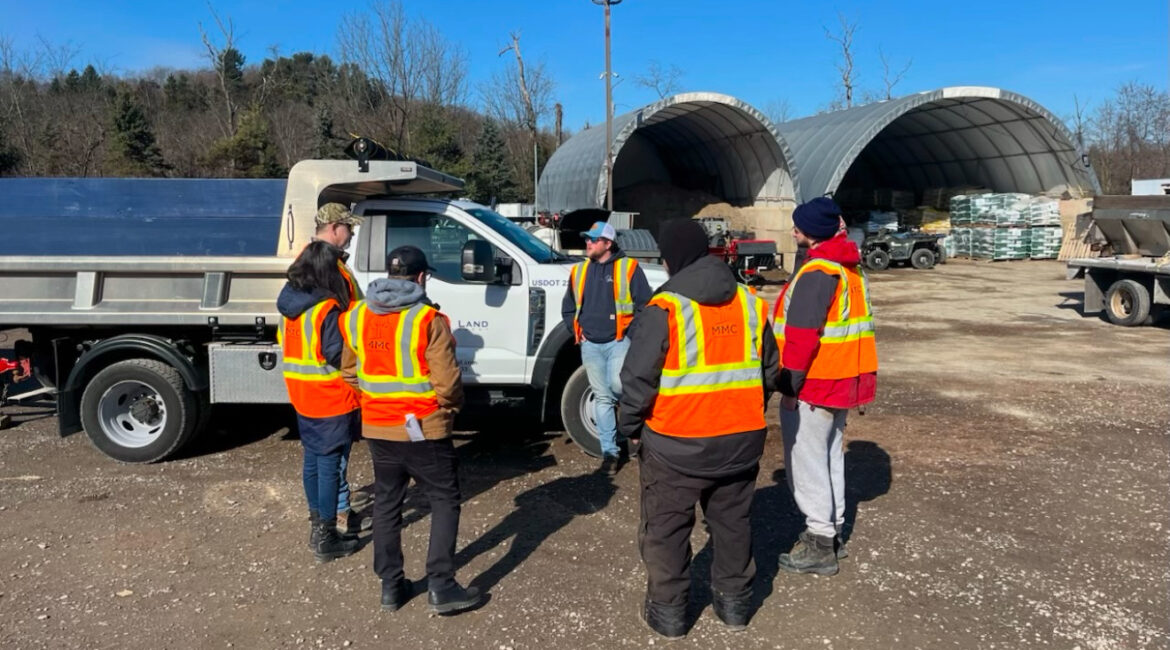We have many different jobs we perform on a daily basis during the Spring. Today, we want to take you on a dive into mulch installation! Spring is a time for renewal, and there’s no better way to usher in the season than with a fresh mulch to your landscape. For the crew at MMC, spring mulch installation is a key service that helps homeowners and businesses alike prepare their yards for warmer weather. It’s more than just tossing down some mulch—it’s a process that involves preparation, precision, and care. Here’s a closer look at what a typical day of spring mulch addition looks like for the MMC crew.
6:30 AM: Morning Briefing & Gear Up
The day begins early with the team gathering at the shop. A quick meeting takes place where the project is reviewed, and tasks are assigned. The crew members discuss the layout of the property, the type of mulch to be used, and any specific details the client has requested.
The team then loads up the necessary tools and materials: mulch, wheelbarrows, shovels, rakes, edging materials, and any other equipment required for the job. Everyone knows their role: some will focus on spreading the mulch, while others handle weeding, trimming, or installing edging. With everything loaded up, the crew heads out to the job site.
7:00 AM: Site Arrival & Assessment
Once the crew arrives at the property, the first task is always a walkthrough of the entire area. They’ll take note of the garden beds that need attention and assess the current state of the mulch (if any). The crew checks for areas that might need extra preparation—whether it’s pulling up old mulch, addressing soil issues, or fixing uneven spots in the garden beds. This initial assessment helps them determine how much mulch they’ll need, and whether any additional steps (like soil amendment or weed prevention) are necessary.
7:30 AM: Old Mulch Removal
For a fresh, clean mulch installation, old mulch is often removed. The crew uses rakes and shovels to gather up the existing mulch, carefully loading it into wheelbarrows for disposal or composting. Removing old mulch allows the soil to breathe and ensures that the new layer of mulch is evenly applied, preventing it from mixing with decomposing old mulch.
While removing the mulch, the crew also keeps an eye out for any weeds that might have sprouted up. If weeds are present, they’re pulled by hand or removed with a weeding tool. In some cases, the team might lay down a layer of weed barrier fabric to prevent future growth. Taking the time to properly clear out weeds and old mulch ensures the new installation looks neat and performs its function optimally.
9:00 AM: Bed Preparation
Once the area is free from old mulch and weeds, it’s time to prepare the soil for the new mulch. The crew checks the soil’s level, making sure that any low spots are filled in and that the bed is shaped properly. This might involve adding or removing some soil to create an even surface.
If the soil appears nutrient-deficient, the crew might amend it with compost or fertilizer to improve plant health before installing the mulch. A healthy, well-prepared soil base ensures that the mulch layer has the desired effect—conserving moisture, keeping weeds at bay, and providing nutrients to the soil as it decomposes.
10:30 AM: Trimming & Edging
With the soil prepared, the next step is to give the landscape a clean, defined look. The crew trims any overgrown plants or shrubs to ensure they’re visible and properly showcased once the mulch is installed. It’s all about creating a balanced, attractive appearance.
The team also focuses on the edges of the garden beds. Clean, straight lines along the border make a huge difference in the overall presentation. They may install or adjust the edging around the mulch bed, whether it’s metal, plastic, or natural stone, ensuring that the mulch stays in place and the edges look sharp.
11:30 AM: Mulch Installation
Now comes the main event: spreading the mulch! The crew begins transporting mulch from the piles to the garden beds, carefully distributing it with shovels and rakes to create a uniform layer. The goal is typically to apply 2–4 inches of mulch across the entire bed to conserve moisture, keep weeds at bay, and provide nutrients to the soil as it decomposes.
Special attention is given to the mulch’s placement around the base of plants and along edges. The team makes sure the mulch doesn’t pile up too high against plant stems or tree trunks, which could cause rot or pest problems. They also adjust the depth of the mulch in different areas to ensure even coverage, especially around shrubs or flowers that may require more insulation from the elements.
12:00 PM: Lunch Break & Check-In
After a few hours of hard work, the crew takes a break for lunch. This time allows them to rest and recharge while reviewing their progress. They also discuss any challenges that have come up—perhaps the need for extra mulch or issues with soil prep—and adjust the plan for the afternoon. Team communication is key to staying on schedule and ensuring everything goes smoothly.
12:30 PM: Final Touches
After lunch, the crew gets back to work, focusing on the finishing touches. This includes smoothing out the mulch layer to ensure it’s evenly spread and making sure the edges look pristine. Any remaining plants that need trimming are taken care of, and the team double-checks for stray mulch on pathways or driveways, sweeping it up to maintain a clean and polished appearance.
The crew also takes time to tidy up any other areas impacted by the work, such as sweeping walkways and tidying up the site. All tools and equipment are cleaned and stored, and any excess mulch is either returned to the yard or left with the client for future use.
2:00 PM: Walkthrough & Client Review
With the mulch installation completed, it’s time for the most important step: the client walkthrough. The team invites the client to take a look at the finished product and ensures they’re satisfied with the work. This is a chance to discuss the benefits of the new mulch—such as moisture retention, temperature regulation, and weed control—and to provide tips on maintenance.
The team also provides the client with helpful advice on how to care for the mulch and when to refresh it. A professional, well-maintained mulch bed can last through several seasons, and the crew ensures the client knows how to get the most out of their new landscape.
3:00 PM: Final Cleanup & Pack Up
Once the client is happy with the work, the crew packs up the tools and prepares to head back to the shop. The mulch installation is now complete, and the team reflects on the day’s hard work. They’ve transformed a property into a cleaner, more vibrant space, and the results speak for themselves.
Conclusion
A spring mulch addition is one of the simplest yet most impactful ways to refresh a landscape. It improves the look of the property, provides essential nutrients to the soil, and helps maintain plant health throughout the warmer months. For the crew at MMC, every mulch installation is an opportunity to create something beautiful and lasting. Whether it’s a residential garden or a commercial property, a fresh layer of mulch is the perfect way to greet the season—and the MMC team is always ready to deliver top-quality results.

